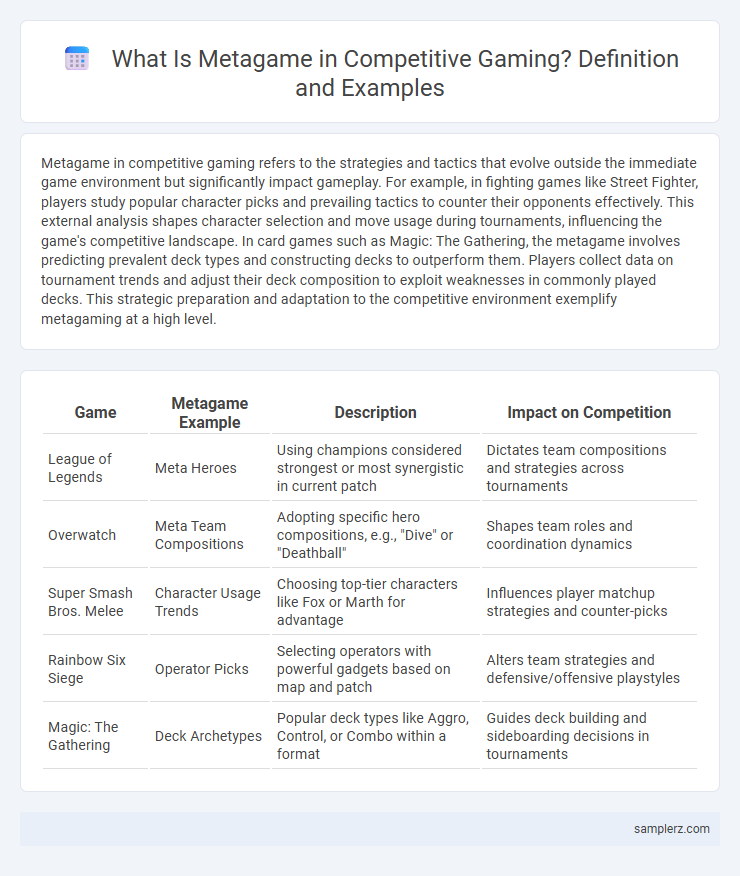Metagame in competitive gaming refers to the strategies and tactics that evolve outside the immediate game environment but significantly impact gameplay. For example, in fighting games like Street Fighter, players study popular character picks and prevailing tactics to counter their opponents effectively. This external analysis shapes character selection and move usage during tournaments, influencing the game's competitive landscape. In card games such as Magic: The Gathering, the metagame involves predicting prevalent deck types and constructing decks to outperform them. Players collect data on tournament trends and adjust their deck composition to exploit weaknesses in commonly played decks. This strategic preparation and adaptation to the competitive environment exemplify metagaming at a high level.
Table of Comparison
| Game | Metagame Example | Description | Impact on Competition |
|---|---|---|---|
| League of Legends | Meta Heroes | Using champions considered strongest or most synergistic in current patch | Dictates team compositions and strategies across tournaments |
| Overwatch | Meta Team Compositions | Adopting specific hero compositions, e.g., "Dive" or "Deathball" | Shapes team roles and coordination dynamics |
| Super Smash Bros. Melee | Character Usage Trends | Choosing top-tier characters like Fox or Marth for advantage | Influences player matchup strategies and counter-picks |
| Rainbow Six Siege | Operator Picks | Selecting operators with powerful gadgets based on map and patch | Alters team strategies and defensive/offensive playstyles |
| Magic: The Gathering | Deck Archetypes | Popular deck types like Aggro, Control, or Combo within a format | Guides deck building and sideboarding decisions in tournaments |
Defining the Metagame in Competitive Gaming
The metagame in competitive gaming refers to the evolving strategic landscape shaped by player choices, game updates, and community trends that influence which tactics dominate. For example, in games like League of Legends, champion picks and team compositions shift based on balance patches and professional play analysis, creating a dynamic environment where adaptation is crucial. Understanding the metagame allows players to anticipate opponents' strategies and optimize their gameplay for higher success rates.
Evolution of Metagames Across Esports Titles
Metagames in competitive gaming evolve as players continuously adapt to shifting strategies, character balances, and patch updates across esports titles like League of Legends, Dota 2, and Overwatch. The rise of new champion compositions and hero picks often reflects community-driven innovation, shifting dominant playstyles over time. These dynamic changes drive the competitive scene's strategic depth and keep fans engaged through unpredictable and evolving gameplay.
Classic Metagame Shifts in MOBA Games
Classic metagame shifts in MOBA games like League of Legends and Dota 2 often revolve around changes in hero or champion popularity driven by patch updates and balance changes. Strategic adaptations, such as evolving team compositions and role prioritization, emerge as players respond to buffs, nerfs, and item reworks that redefine power dynamics. These metagame evolutions influence drafting strategies and in-game decision-making, reflecting the dynamic nature of competitive play.
Impact of Patch Updates on the Metagame
Patch updates significantly reshape the metagame in competitive gaming by altering character abilities, weapon stats, and game mechanics, forcing players to adapt strategies. For example, a nerf to a dominant champion in League of Legends can lead to a surge in the viability of previously underused heroes, diversifying team compositions. These balance changes create shifts in player behavior and meta trends, making adaptability a critical skill for success in esports tournaments.
Team Composition Strategies in Tournament Play
In competitive gaming tournaments, metagame strategies often revolve around optimizing team compositions to counter popular picks and exploit game balance shifts. Effective team compositions blend roles such as tanks, damage dealers, and support characters to maximize synergy and adaptability against diverse opponents. Analyzing opponent tendencies and patch updates enables teams to refine their drafts, securing strategic advantages that influence match outcomes.
Counter-Play and Adaptation: Staying Ahead in the Meta
In competitive gaming, metagame evolves as players constantly develop counter-play strategies to disrupt dominant tactics, exemplified in games like League of Legends where team compositions shift to counter prevailing champion picks. Adaptation is crucial; players analyze opponents' tendencies and adjust builds or playstyles to maintain an advantage within the meta. Staying ahead in the meta requires continuous learning, strategic foresight, and flexible decision-making to outmaneuver competitors effectively.
Player Innovations That Changed the Metagame
Player innovations that changed the metagame include Faker's aggressive mid-lane strategies in League of Legends, which revolutionized champion picks and playstyles in professional play. In Super Smash Bros., players like Armada introduced technical movement and combo optimizations that redefined character viability and match tempo. These groundbreaking tactics pushed developers to rebalance characters and influenced the evolving meta across tournaments worldwide.
Role of Coaching in Shaping Competitive Metas
Coaching significantly influences the competitive metagame by analyzing player performance data and developing strategic adaptations tailored to evolving game mechanics. Coaches guide teams in optimizing hero picks, counter-strategies, and in-game communication, driving meta shifts through informed decision-making. Effective coaching creates a feedback loop where meta advancements are continuously refined, solidifying dominant playstyles within the competitive landscape.
Balancing Metagame Diversity for Fair Play
Balancing metagame diversity in competitive gaming involves carefully adjusting character abilities and game mechanics to ensure no single strategy dominates, promoting fair play and variety. Developers analyze win rates and pick rates across different patches to identify overpowered tactics and implement targeted nerfs or buffs. Maintaining equilibrium prevents stagnation, encourages strategic innovation, and sustains player engagement across esports titles like League of Legends and Dota 2.
Predicting Future Metagame Trends in Esports
Esports analysts use data-driven models and player behavior patterns to predict future metagame trends, such as emerging hero picks in games like Dota 2 and Overwatch. Understanding patch updates and player adaptation rates helps forecast shifts in competitive strategies and team compositions. These predictions guide coaches and players in optimizing training regimens and draft strategies to maintain a competitive edge.

example of metagame in competitive gaming Infographic
 samplerz.com
samplerz.com